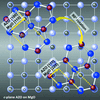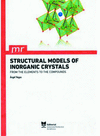issue contents
April 2020 issue

Cover illustration: Epitaxial growth of nonpolar aluminium-doped zinc oxide thin film on flexible substrates through a quasi-perovskite lanthanum manganate buffer layer, see Yongkuan Li et al. [(2020). Acta Cryst. B76, 233-240].
research papers
Download citation


Download citation


Structural features of O—H⋯O hydrogen bonds are related to the frequencies of O—H stretching and to the electric polarizability of the donor and acceptor functional groups in organic salts of pyromellitic acid. Such correlations could be useful to the rational design of optical materials.
Download citation


Download citation


The attachment energy method is used to predict the crystal habit of a series of tricyclic imides with the aid of DFT-D calculations.
Download citation


Download citation


Dinuclear CuII complexes with 3,5-dinitrobenzoates and rigid N,N-donor ligands (2,2′-bipyridine and 1,10-phenanthroline) have a stereochemistry that results in a ground-state configuration with  as the magnetic orbital with spin-isolated behavior.
as the magnetic orbital with spin-isolated behavior.
Open  access
access
 access
accessMost articles dealing with RSi2 and R2TSi3 compounds are only interested in one specific compound or in a series of compounds with varying T elements while keeping R fixed (or vice versa). Here, the focus lies on the complete space of 2:1:3 and 1:2 silicides. In addition further variations of superstructures are revealed and focus on crystallographic properties.
Medium-range atomic ordering in Cu2Se appears right after the phase transition and is sustained over a wide temperature range as observed using in situ TEM investigations.
Download citation


Download citation


A crystallographic study of aconine hydrochloride monohydrate (AHM) as a novel salt form is reported. A green chemistry technique and structural confirmation of AHM have offered a rational approach for improving the pharmaceutical technology of WuTou injection, together with the potential for obtaining a potent drug with minor toxicity.
CCDC reference: 1920259
Download citation


Download citation


Reversible solvent-triggered single-crystal-to-single-crystal transformations are observed between two copper(II) azamacrocyclic complexes and characterized by single-crystal X-ray diffraction and in situ powder X-ray diffraction.
Epitaxial growth of c-plane and m-plane hexagonal-structure aluminium-doped zinc oxide thin films is achieved for the first time on flexible substrates using cubic-structure seeds. This technique offers transparent electrodes and epitaxy seeds for orientation-controllable ZnO (and GaN) devices.
Download citation


Download citation


The novel supramolecular host–guest architectures of cocrystallized 18-crown-6 with isophthalic derivatives, 18-crown-6·6(5-hydroxyisophthalic acid)·10(H2O) and 18-crown-6·2(trimesic acid)·2(H2O), mainly stabilized by O—H⋯O hydrogen bonding and π⋯π interactions, have been described. Intra- and intermolecular interactions are analyzed and quantified by Hirshfeld surfaces derived from single crystal XRD data.
A Cambridge Structural Database analysis of methylated cyclopentadienyl (Cp) complexes indicates the presence of C—H⋯π, parallel displaced stacking and large offset stacking interactions as the main non-covalent interaction types. This conclusion is supported by electrostatic potential maps.
Deposition of Zn or ZnO adjusts growth of equiaxed and columnar crystals or their coexistence. The ratio of equiaxed and columnar crystals tune carrier mobility and heat transport. The structure of the equiaxed-crystal buffer layer is appropriate to enhance zT value.
Download citation


Download citation


Open  access
access
 access
accessDeuteration severely influences all temperature-dependent structural modifications in the hybrid perovskite FAPbBr3. It leads to partially-ordered temperature-dependent structural modifications in which two symmetry-independent molecule positions with additional dislocation of the molecular centre atom and molecular angle inclinations are present.
Download citation


Download citation


This work focuses on solving the crystal structure of diaquabis(omeprazolate)magnesium dihydrate and evaluating its mechanical properties.
CCDC reference: 1920020
Download citation


Download citation


Single crystals of an organic semiconductor, namely the 4-cyano-N-methylpyridinium salt of the 5,6-dichloro-2,3-dicyanosemiquinone radical anion, were studied using X-ray diffraction at 100–370 K and 0–6 GPa.
book reviews
Free 



 journal menu
journal menu







































